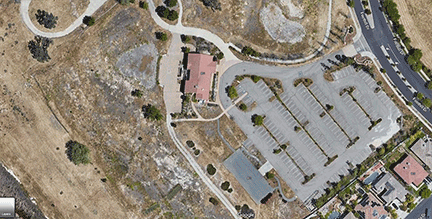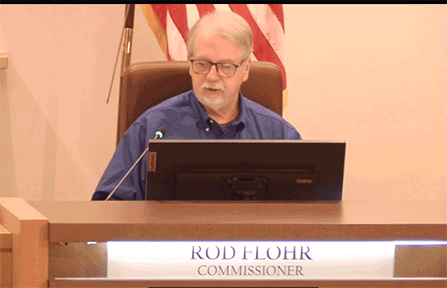In what should be considered the biggest time waste to date in 2023, the Brentwood Planning Commission is set to discuss two items on the Deer Ridge Clubhouse Tuesday night.
- Under Item F.1, the commission will discuss the response to questions presented by commissioner Rod Flohr.
- Under Item F.2, the commission will look to approve a design review application for landscape improvements. This is required after various landscape improvements were not included in the original approval in 2000. This includes 405 grape vines, 420 olive trees, concrete patio and a wood trellis. Staff conducted a site inspection on August 7 and noted that some of the improvements have been completed, including the rows of grape vines, while the olive trees have not been planted and the patio improvements have not been completed
However, because of the actions of Commissioner Rob Flohr pushing the issue and asking 17-questions regarding a CUP, it has shown some negative impacts of how Measure Q punishes applicants seeking a CUP or property improvements that fall within the Measure Q overlay map. The planning commission must now decide if they want to take Flohr’s concerns seriously and further discuss it, or simply tell him to kick rocks and let McCauley move forward–I say make Flohr kick rocks and move forward.
In all seriousness, depending on a legal interpretation of whether a wine bar/restaurant falls under a clubhouse or not (which was approved under the older Conditional Use Permit in 2000) or if it does not, it would require a vote of the public as to whether or not residents would approve a wine bar at the Deer Ridge Clubhouse—simply absurd!
Under Measure Q, which was approved with 64% of the vote in November, it now protects approximately 175 parcels throughout the city to keep the parcels as designated open space. Any changes to the parcels over the next 40-years, except in certain circumstances, would need voter approval–with the Deer Ridge Clubhouse falling within the overlay, its now impacted. The CUP, also similar, is up for debate as it must define whether a clubhouse is a restaurant/wine bar.
If Sean McCauley truly wants a wine bar at the upcoming Deer Ridge Clubhouse, depending on interpretation and decisions made, he may have to pay to place the question for residents of Brentwood to decide if it should be allowed or not– again, this is absurd.
It also pushes the issue as to whether or not Planning Commissioners, or City Council Members, for that matter, are treating certain applicants differently while forcing them to jump through hoops while giving COSTCO and others a free ride to approval–which was the point WCHB Development, LLC/Discovery Builders Inc. (AKA Seeno) was trying to make when he pulled the CUP for COSTCO several weeks ago.
The Deer Ridge Clubhouse appears to now be paying unintended consequences and could becomes a casualty due to Measure Q language which was pushed by Councilmembers Jovita Mendoza, Susannah Meyer and former councilmember Karen Rarey all in the name of “open space”. Depending on interpretation, it may be cost prohibitive to do anything outside the scope of a CUP issued in 2000 because the cost of an election makes little sense for any applicant on a project like this because of the investment needed to bring clubhouse up to standards.
In July of last year, Councilmember Mendoza told the residents of Brentwood to be careful who they elect because not everyone will protect open space.
I agree, voters in 2024 must be very careful because Mendoza, Meyer and Bryant are all up for election. Mendoza and Meyer have been huge disappointments, time wasters for both staff and the public, and created plenty of unintended consequences through policy and harming businesses that must be undone once they are off the council. There could have been language added within Measure Q to resolve issues like the Deer Ridge Clubhouse but they wanted to go the ballot route on every parcel.
Ironically, the new Deer Ridge Clubhouse proposed plans not only protects open space, it adds to it with trees, vegetation while upgrading a clubhouse to fine dining with the potential of a wine bar–it basically improves the whole Deer Ridge area by no longer being an eye sore or space to vandalize. Its a shame a micromanaging council mislead the public on what Measure Q would do and now Brentwood could miss out on a nice addition to area.
At some point, councilmembers need to get off theory on paper and work in the real world. Measure Q is a perfect example of policy failure by councilmembers not seeing the big picture or impacts from tunnel vision policy.
Here is the staffs response to the 16-questions by Commissioner Rod Flohr at the June Planning Commission Meeting.

Photo: Google Maps
STAFF’S RESPONSES TO THE COMMISSION’S QUESTIONS
This section provides staff’s responses to the Commission’s questions regarding CUPs.
-
Why are Conditional Use Permits important?
Conditional use permits lay out the rights and obligations related to the use of a property. As noted above, a CUP can provide a vested right for a property owner to develop or continue using property in the manner authorized by the CUP. Property owners must also comply with any conditions of approval contained in a CUP. Brentwood Municipal Code (“BMC”) § 1.16.040.
Conditional use permits also provide a critical vehicle for a city to approve of a use without simply deeming it a permitted use, which would carry no additional conditions. Uses that are permitted by right do not need further approval to operate, though their design may still be subject to city review and approval. With a conditional use permit, the City can tailor the conditions to the impacts of a particular use, within the parameters of the law.
-
Why review the CUP for the Deer Ridge clubhouse?
The uses of the Deer Ridge clubhouse must be consistent with the property’s CUP. If the property is currently being used in a manner that is inconsistent with the CUP, the City could initiate an investigation and determine whether to issue a notice of violation or take other appropriate action (e.g., BMC §§ 1.16.040-050). Additionally, proposed changes to a site or building contained in a building permit application or design review application must also be consistent with the property’s CUP. The City reviews such changes after it receives a complete application for a building permit or design review.
-
What limitations are there on the City’s review process that might prevent the Planning Commission from ruling on anything it might find deficient in the CUP? Are there any boundaries around what the Planning Commission may consider?
Property owners are entitled to notice and an opportunity to be heard before the City takes actions that could impair the rights protected by a CUP. In this case, the City cannot modify or revoke the CUP, or determine that the property owner has violated a condition in the CUP, without first notifying the property owner of the potential violation and providing an opportunity for the owner to present facts or evidence that could inform the City’s decision. If the Planning Commission believes the property may currently be in violation of the CUP, the Commission could approve a motion requesting that staff investigate the potential violation and prepare a report and recommendation to the Planning Commission in accordance with section 17.890.006 of the Municipal Code.1
In addition, the Planning Commission must ensure that it does not prejudge the merits of any applications that are not presently before it
-
Please provide copies of CUP No. 00-04, all supporting documentation, and all documents referenced in the CUP.
Copies of the resolution approving CUP No. 00-04 and available supporting and referenced documentation are included as attachments to this report.
-
Is the clubhouse severable from the golf course?
Yes. The CUP allows a set of uses for the clubhouse and surrounding property, and does not require that the golf course be in operation in order for the clubhouse to be used.
-
Is a clubhouse the same thing as a restaurant?
A clubhouse is not necessarily the same thing as a restaurant. But in this case, the CUP provides guidance as to what kinds of uses are permitted within the clubhouse. CUP No. 00-04 allows for the operation of a commercial “dining room/bar.” In general, the use of a property must be “substantially the same or similar” to the original permitted use, but does not need to be identical. From a land use perspective, operating a restaurant is similar to operating a commercial dining room/bar. Therefore, a restaurant could be an allowable use under the existing CUP, even if there may be some differences in the restaurant’s hours of operation or number of patrons relative to previous uses of the dining/bar facility.
-
Does the removal of some uses and using that space for the restaurant change the use enough to require amending the CUP?
This question has two components: (1) whether a new or amended CUP would be required if the property owner were to operate a restaurant without also using the clubhouse for the other uses permitted in the CUP, and (2) whether an amendment to the CUP would be required if the property owner repurposes space that was previously dedicated to a different use in order to provide additional space for the dining/bar use.
For the first question, the CUP authorizes several uses of the property, both inside and outside of the clubhouse, and does not require that all of the uses be maintained in order for the CUP to remain valid. The second question depends on the details of how the space in the clubhouse will be used. In general, vested rights do not allow for the expansion of a nonconforming use. However, not all changes in the interior use of a building would constitute an expansion of a nonconforming use. In the absence of a specific proposal, staff cannot provide a definitive answer at this time.
-
Does operating the clubhouse as a restaurant change the use enough to require amending or superseding the CUP?
No – opening a new restaurant in the existing clubhouse building would not, by itself, require a new or amended CUP. As noted above, the use of a property must be “substantially the same or similar” to the original permitted use, but does not need to be identical. Operating a restaurant is similar to operating a commercial dining room/bar, and therefore could be an allowable use under the existing CUP.
-
Does operating a restaurant create a need for more conditions of approval?
CUP No. 00-04 does not contain a detailed list of conditions concerning the operations of the dining/bar facility. As described below, the City could modify the CUP to include additional conditions of approval with the agreement of the property owner. The City may also be able to add or clarify conditions of approval, if the changes do not impair the rights protected by the CUP.
-
Do the findings in the action section (NOW, THEREFORE, BE IT RESOLVED) conflict with the usage as a restaurant?
No – the use of the existing clubhouse building for a restaurant does not conflict with the action section of Planning Commission Resolution No. 00-57. That section includes approval for the “clubhouse, consisting of a pro-shop [and] dining room/bar,” among other uses. The restaurant use is consistent with the dining room/bar authorized by the resolution.
-
Do all of the whereas clauses remain true if the use is a restaurant?
Yes, as noted above, a restaurant is similar to the dining room/bar use discussed in the whereas clauses of Resolution No. 00-57
12.Have all Conditions of Approval been met?
Yes, staff confirmed compliance with all conditions of approval prior to authorizing occupancy of the clubhouse, with the exception of #5, which relates to the construction of Foothill Drive from Balfour Road to Concord Avenue. Foothill Drive currently terminates at Pearson Drive, approximately 600 feet west of Concord Avenue.
13.Were all supporting documents reviewed to make sure the Conditions of Approval were met?
Yes – staff goes through a standard review process to ensure that all conditions of approval have been complied with before approving occupancy.
14.Does the CUP allow the owner to meet all of their goals for the property? If not, are there any options available to the owner to amend the CUP or otherwise enable their unmet goals?
The April 16, 2023 letter from Sean McCauley Investments, Inc., included proposals for a new pool and cabana facility, along with a second clubhouse building that would house a full-service spa, lounge, and wine bar. Staff informed Mr. McCauley that a pool and cabana facility could be allowed under Measure Q as a permissible recreational use, but would likely require a new or amended CUP. Although CUP No. 00-04 authorized a pool and cabana, those facilities were never constructed, and so a new or amended CUP would likely be required, as the right to construct and operate those facilities arguably never vested. Staff also informed Mr. McCauley that a spa and wine bar, located in a newly constructed second clubhouse building, most likely would not qualify as a recreational or open space use under Measure Q. And CUP No. 00-04 does not provide a vested right to build a second clubhouse for the purposes of housing a spa and wine bar. Therefore, under Measure Q, a vote of the people would likely be required to approve construction of the spa and wine bar.
15.What options exist that would be available to remediate or mitigate any potential negative findings, if there are any?
Staff assumes the term “potential negative findings” in the question refers to a finding by the City that a current or proposed use of the property is inconsistent with the CUP. The options for addressing that situation depends on the nature of the finding. As an initial matter, staff is not aware that the property is currently in violation of the CUP. But, if after an appropriate investigation the City determines that the property is being used in a manner that conflicts with the CUP, the City could work with the owner to address the violation in several ways. For example, if one or more conditions of approval have not been satisfied, the City could work with the owner to ensure compliance with the conditions of approval. Alternatively, the property owner could request a modification to the CUP, which would be reviewed by the Planning Commission at a future hearing. The modification could be allowed under Measure Q, if it does not expand the nonconforming uses of the property. If the “negative finding” does not concern a current use of the property, but rather a proposed use described in a building permit application, there are a few options.
After learning that the uses proposed in conjunction with the building permit application do not comply with the CUP, the property owner could amend the proposal and file a new application that complies with the CUP. The owner could also request a modification to the CUP, which would proceed to the Planning Commission for review. As stated earlier, the only application currently pending before the Planning Commission is a design review application for landscaping-related improvements, which does not include proposed changes to the use of the clubhouse building.
16. For each option, how can the Planning Commission manage them to minimize days in resolution?
All of the above options could proceed expeditiously, although certain procedural requirements may apply. For example, if the City believes that the property may be in violation of the CUP, it must provide notice and an opportunity for the property owner to be heard before making a final decision. Likewise, proposed modifications to the CUP would require notice and a public hearing prior to approval (see BMC 17.830.004(B)), and potentially environmental review.
-
If there were some kind of negative finding after the restaurant is already open, would there be any consequences for the restaurant? What steps can the Planning Commission take to minimize any risk to the restaurant operator?
Similar to the question above, staff assumes the term “negative finding” refers to a determination by the City that the use of the property is not consistent with the CUP. In that case, yes, there can be negative consequences if an owner uses property in a manner that is inconsistent with the applicable CUP. To minimize these risks, staff can provide guidance to the owner as plans for the property develop. The property owner should also submit all applications for any required building permits. Those applications provide an opportunity for the owner to receive confirmation from the City that the proposed changes are consistent with the CUP.
F.1 Deer Ridge clubhouse CUP – Future Agenda Item follow-up
Also on the Agenda: Brentwood Planning Commission to Talk Lazy Dog Restaurant
Brentwood PLANNING COMMISSION
City Council Chambers 150 City Park Way
Zoom Webinar ID: 87350296630

Mike Burkholder
Publisher of ContraCosta.news
[email protected]

